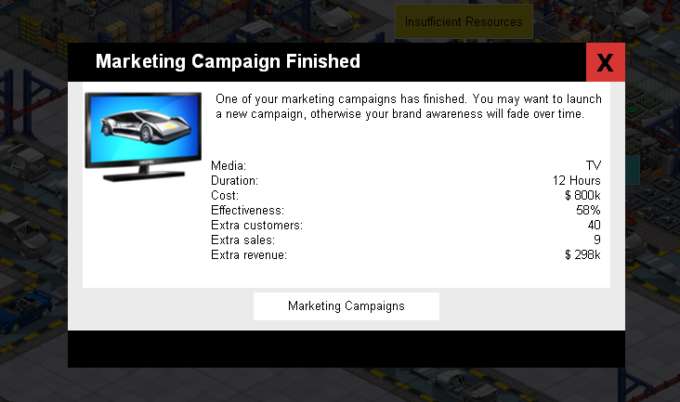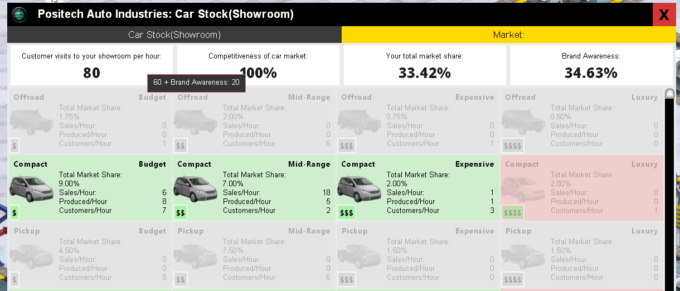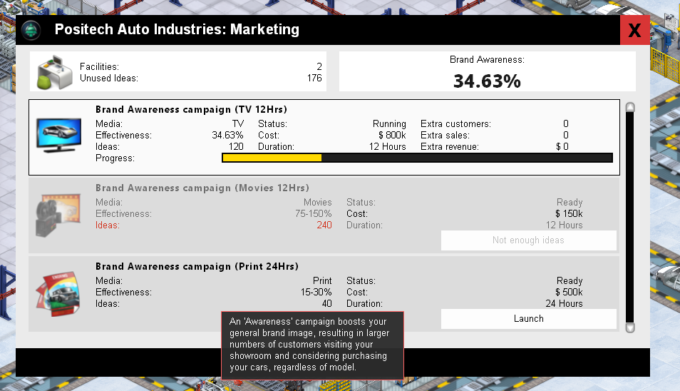If you aren’t already a player of Production Line, you probably dont realize that there is a part of the game where you can place down marketing facilities (once researched). These allow you to generate a flow of ‘ideas’ which are basically marketing points. Those points get spent on new marketing campaigns, in TV, Print or Movie form. Right now the only target for these campaigns is ‘brand awareness’ which essentially means more people will come into your car showroom and consider buying your cars. So far so good… This system has been in the game for a while, it works, there are no bugs, everything is kind of working as intended.
But yet it isn’t really, because it turns out that generally speaking people just don’t use the marketing features at all. They get excited when they research them, throw them down, and then run some campaigns (which cost a lot, but due to balance issues, some players at this relatively late stage of the game have LOADS of money, so its not an issue), and just kind of assume they worked, without really bothering with them any more. The major problem was the lack of feedback to the player on the progress of the marketing campaign, and its effects, PLUS there were balance issues meaning they may have been relatively pointless anyway.
Dealing with the GUI stuff first, I have replaced the event pop-up in the bottom right of the screen (easy to ignore) with a central modal dialog for whenever a marketing campaign ends which prompts you to run another campaign, and also for the first time it now gives you a breakdown of the extra customers the campaign bought in, how many cars they bought, and the revenue that this generated:

I also changed the GUI for the market screen which shows the current number of visitors to your showroom, so that it has a tooltip which breaks it down into the ‘base’ number plus those who are bought in by your marketing efforts:

And finally I’ve changed the GUI for the marketing screen itself, so that for campaigns which are currently being run, you can keep an eye on those customer, sales and revenue numbers as the campaign is running:

So with luck, that has a major impact on encouraging people to use the marketing feature in the game. They should no longer be oblivious to the effects of the campaign (which is probably the biggest factor), plus they can no longer be unaware that a campaign has ended. Obviously a campaign ending does not automatically mean you have enough marketing ideas to launch another, and maybe I need more hints and pop-ups/GUI indicators to point out to the player that they now have sufficient ideas for a new campaign, or to prompt them to maybe invest in some more marketing facilities.
So anyway… thats just half the problem, which was UI/UX related. The other problem was balance/Sim related, and that also needed some tweaking. Like everything related to balance in a game this complex, it will probably require a number of iterations to get the numbers just right, as designing a game with so many inter-connected parts really is a massive number-tweaking problem. The problem here was that the player was essentially never reaching a point where the number of customers in the showroom was a limit, so they never saw any pressing need to spend on marketing to get more customers through the doors.
Obviously the player can always sell to every single customer that walks through the door, IF their prices are low enough, but this may entail selling cars at a loss. What I need is to ensure that the player sees that by enlarging the number of potential customers, the number of actual buyers is going to go up, WITHOUT reducing prices. This may be intuitively obvious to some, but maybe not others. If you have 80 showroom visitors per hour, and produce 20 cars per hour, would you automatically think you need more visitors? This is hard to convey.
Regardless of communicating this, it did seem like the number of customers was basically not enough of a constraint, so I have adjusted the numbers so that fewer customers show up, but they are more flexible on price. That *should* mean that balance is not vastly affected, whilst keeping customer numbers low enough now that the player sees an incentive to boost them with marketing. I suspect it wont be enough, and I’ll need to communicate this in other ways, maybe by showing the total potential pool of customers, and what percentage of them actually check out your cars? I have a stat already for market share, but thats sales, not views…
Anyway…. I think its all progress on the playability and balance of the game. Bit by bit, the game is getting better every day :D